Digital Camera Technology
Shooting a photo
digitally produces a less accurate image than scanning a photo shot on
film with a flatbed scanner using a high spi setting. This is because
digital cameras capture data using photosensitive electronic sensors.
These sensors record brightness levels on
a per-pixel basis. However, the sensors are usually covered with a
patterned color filter that has red, green, and blue areas. Although the
filter attempts to capture all detail that the lens sees, it is unable
to completely do so due to its design.
A
CMOS sensor (left), such as this one from Nikon, is the standard
imaging device on a digital camera. The Bayer filter arrangement (right)
uses red, green, and blue pixels and is very common in digital cameras.
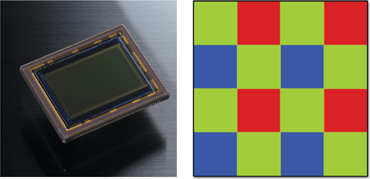
The filter used is
typically the Bayer filter arrangement, which contains two green pixels,
one red pixel, and one blue pixel. The Bayer filter uses more green
because the human eye has an increased sensitivity to green. This filter
allows the image to record the brightness of a single primary color
(red, green, or blue) because digital cameras work in the RGB color
space.
Not all the properties of
film can be fully imitated by the computer sensors in a digital camera,
so the camera must interpolate the color information of neighboring
pixels. This averaging produces an anti-aliased image, which can show
visible softening. When anti-aliasing is present, hard edges are blended
into one another. Sometimes this can be desirable (with low-resolution
Internet graphics where you reduce file size by limiting color). Other
times, anti-aliasing can produce an undesirable softness when you print
an image. Depending on the colors in the original image, a digital
camera might only capture as little as one-fourth of the color detail.
For example, if you had a desert scene with lots of red detail and
little green or blue, the sensor would rely on the red areas of the
filter (which only cover a fourth of the sensor face).
Does this mean you should
shoot film only? Of course not; I shoot both. But it’s important to
shoot for what you need. There are strengths and weakness of both film
and digital capture (as well as several stylistic decisions).
Ultimately, film captures a high-quality image that can be optically
enlarged using the negative. However, digital capture can be more
convenient and affordable because you get instant feedback on the images
you have just taken, and you eliminate the time-consuming process and
costs associated with developing the film.
It
is important to shoot at a high pixel count (which can be accomplished
by setting the camera to shoot in a high- or best-quality mode). You can
always crop or shrink the image for output or display, but you should
avoid enlarging the image if you don’t have to. When a digital image is
enlarged, it can create unwanted image softness or pixelization (a
visible blockiness). Capture as much pixel data as possible to minimize
digital upsampling (increasing the resolution of the image).
Shooting JPEG vs. Raw
When digital cameras
became commercially available, the memory cards used to store pictures
were very expensive. Many photographers could not afford multiple or
high-capacity cards, so they wanted more images to fit on a single,
smaller card. Many users also emailed their pictures to friends and
family. Small file sizes enabled consumers who lacked an understanding
of digital imaging to attach photos to emails with minimum technical
headaches. With these two scenarios in mind, manufacturers turned to an
Internet-friendly format, JPEG (Joint Photographic Experts Group). It
was a proven technology and one that was familiar to many users.
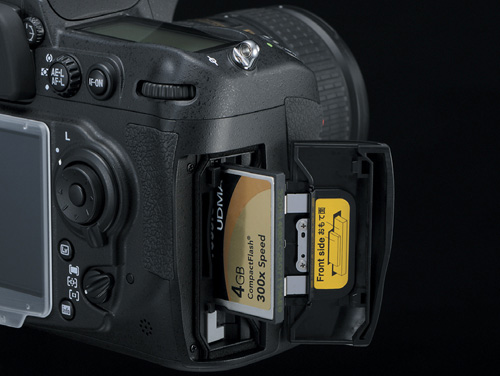
The JPEG format is
extremely common because most hardware and software manufacturers have
built support for it into their products. The JPEG format is also
extremely efficient at compressing images, and it is a good format for
continuous tone images, such as photos. A JPEG file looks for areas
where pixel detail is repeated, such as the color blue in a photo of the
sky. The file then discards repeated information and tells the computer
to repeat certain color values or data to re-create the image.
The
JPEG Options dialog box is available when you modify a JPEG file with
Photoshop. When saving, you can adjust the Quality slider to reduce file
size. It is best to leave Quality set to maximum if you will be making
future edits to the image: This applies the least compression that could
damage the image’s appearance.
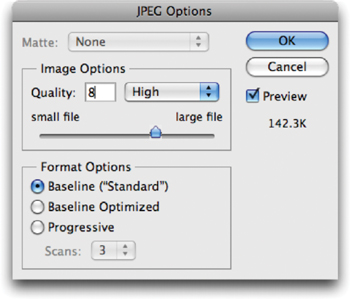
Although JPEG is a good
format for distributing images (due to their compatibility and small
file size), it is not great for image acquisition or production. A JPEG
file is lossy, meaning that every time you modify it in Photoshop and
resave as a JPEG,
additional compression is applied to the image. Over subsequent
compressions, the image quality can noticeably deteriorate. This is
similar to the act of making a photocopy of another photocopy:
Additional image deterioration occurs with each processing step. The
visible loss in image detail or accuracy is referred to as compression artifacts.
This
image was captured as both a raw and a JPEG file when it was shot. The
picture was taken with a Nikon D300, which can simultaneously write both
files to the memory card when shooting.

So, if JPEG is inferior,
why do so many people use it? Money and resistance to change are the
simple answers. It’s a lot cheaper to shoot JPEG images because you
don’t need to buy as many memory cards. Certain scenarios like sports
and photojournalism often rely on the speed associated with smaller
files as well. Additionally, even many pros have been slow to abandon
JPEGs due to fear of change. Learning how to use new technology requires
time, something that most people are short of these days.
Tip: Workaround for Unsupported Cameras
If Photoshop does not
support a particular raw format used by your camera, use the software
that shipped with the camera. The image can be converted into a 16 bit
TIFF image (a high-quality file with no compression), which Photoshop
can open.
Newer digital cameras,
generally the pro models, offer newer formats, typically called raw.
These raw (or native) formats have several benefits over shooting to
JPEG. The images are usually captured at a higher bit rate, which means
that the pixels contain more information about the color values in the
image. Most raw files have a depth of 10, 12, or even 16 bits per
channel instead of the 8 used by JPEG. The raw format also has a greater
tonal range; hence, there is a better exposure for shadows and
highlights. This extra information makes your
work in Photoshop easier because it adds greater flexibility and
control in image adjustments and color correction. You should have less
work to do in Photoshop as well, because the image captured has more
color information than a JPEG would have.
Raw files can be two to six
times larger than JPEG files. This extra data is used to hold more image
detail, which can reduce, or even eliminate, compression artifacts
found in JPEG files. However, that extra data can increase the time it
takes for the files to write to the memory card.
Tip: Camera Raw for TIFF and JPEG?
Although the Camera Raw
interface can be used for JPEG and TIFF files, those images have already
had the camera’s processing permanently applied to the image. Shooting
raw has many benefits and should be fully explored by reading the
documentation that accompanies your camera.
The raw file captures
the unprocessed data from the camera’s image sensor. Although your
camera may contain settings for sharpness, exposure, or lighting
conditions, the raw file stores that setting as modifiable information
and captures the original (unmodified) data that came through your
camera’s sensors. This is very useful because it lets you easily adjust
white balance within Photoshop. Each manufacturer treats the format
differently, using a proprietary format. Fortunately, Photoshop
frequently updates its raw technology to support the newest cameras on
the market. To find out if you can access a particular camera format
from within Photoshop, visit Adobe’s Web site at www.adobe.com/products/photoshop/cameraraw.html.
Because the raw data is
unprocessed, you must essentially “develop” the image data inside
Photoshop. You’ll be presented with several choices when opening a raw
image. You can choose to adjust several options related to the image, as
well as the lens and lighting conditions. All the adjustments made in
the Camera Raw dialog box are nondestructive, meaning the original image
is preserved in pristine condition. You can “tweak” the image after
shooting it, including being able to easily save those changes and apply
them to similar exposures.
The
Adobe Camera Raw dialog box is a versatile environment for “developing”
your pictures. The image Ch03_Overhang.RAW is included on the DVD.
Choose File > Open and navigate to the file . In Photoshop CS5, you can even make localized adjustments by
painting an area to select it and then use sliders to modify it.
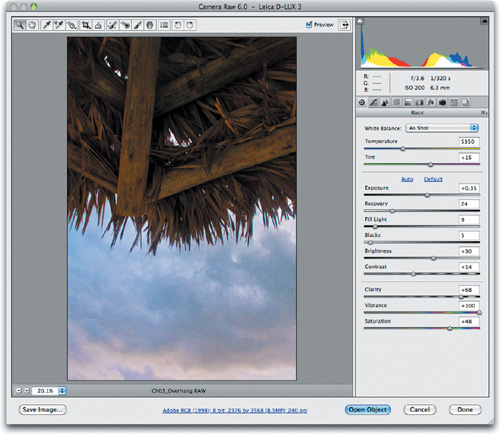
The Camera Raw dialog box has continued to evolve since it
was first introduced as a purchased add-on to Photoshop 7. Subsequent
versions of Photoshop have updated the user interface. Be sure to watch
my detailed video tutorial to learn more about this powerful developing
tool. Fortunately, the Camera Raw dialog box is fairly intuitive,
especially once you understand the concepts of adjusting images.
|
In 2004 Adobe released the
Digital Negative Specification (DNG) file format. The code and
specifications were made publicly available so manufacturers could build
support for the format into their products. The goal was to replace
several proprietary raw file formats with a universal format. Despite
initial optimism, camera manufacturers have been slow to adopt it (some
even refusing). At this point, DNG files are a useful way to archive raw
files and attach additional metadata. You can find out more about DNG
by visiting Adobe’s Web site at www.adobe.com/products/dng/main.html.
|
Acquiring Images from a Digital Camera
There are two major ways of
downloading images from a digital camera. Which connection type you
choose will depend on your work environment and budget for additional
hardware.
Tip: Make Backup Copies
You may want to work with a
copy of your transferred image, especially if you are just getting
started in Photoshop. Many users will duplicate a folder of images and
work with those. Others will burn a copy of the original images to a CD
or DVD for backup. Preserving an original digital file is a good idea
for future use. If you are shooting raw, there is no need to duplicate
the raw file. The modifications to the image are stored in a separate
sidecar file in the folder with your images.
The first method involves
plugging the camera directly into the computer. Many cameras ship with a
connecting cable (generally USB). The advantage of this approach is
that it doesn’t require an extra hardware purchase. The primary
disadvantages of this method are that it ties up the camera, and it is
hard on delicate ports built into the camera. If you break the USB port
by constantly plugging in and unplugging a camera, it can lead to an
expensive service bill. The data port is interconnected with several
other systems on the camera; a break at one end can result in problems
in other areas. Additionally, if the camera’s battery were to be
depleted during image transfer, the memory card and its contents can
become corrupt.
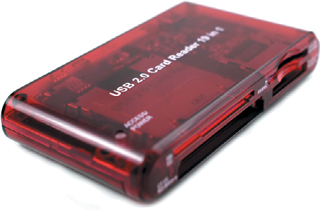
A better option for
downloading images from a digital camera is to purchase a stand-alone
memory card reader. There are many options available, so consider these
questions and choose wisely:
Do you need only one card format, or do you need to read multiple formats?
Do you want a read-only device, or do you want to be able to erase and reformat cards while they are in the reader?
How
fast do you want your files to transfer? Be wary of card readers that
are USB 1, which can take a long time to transfer files. Look for USB 2,
USB 3, FireWire, or eSATA for faster data rates. Laptop users with a
card slot can purchase an effective card adapter for fast file transfers
without tying up ports.
Do
you want to transfer multiple cards at once? Some readers allow for two
or even four cards to be mounted at one time so you can initiate a
large transfer and walk away.
Note: Transferring Files
The
actual transfer of photos is not handled by Photoshop. Rather, you can
use Adobe Bridge CS5, which includes a Photo Downloader (File > Get
Photos from Camera). If you are not using Bridge, the files are handled
natively by your computer’s operating system. Just manually copy them to
a folder on your computer.